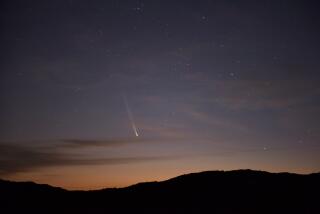Rosetta spacecraft catches its comet! Here’s what comes next
On Wednesday morning the Rosetta spacecraft kept a 10 year date with an icy comet the size of a mountain.
About 2:30 a.m., the spacecraft made the last of a series of 10 engine firings it began in May that allowed it to enter a triangular shaped orbit just ahead of its speeding, volatile target known as 67P/Churyumov–Gerasimenko.
Starting now, Rosetta is no longer chasing a comet, it is traveling along with it.
“We have been approaching 67P for such a long time, it is almost surreal to now actually be there,” says Holger Sierks of the Max Planck Institute in Germany in a statement. “Today, we are opening a new chapter of the Rosetta mission. And already we know that it will revolutionize cometary science.”
Rosetta and its comet are currently out between the orbits of Mars and Jupiter, about 250 million miles from Earth. Together at last, they are hurtling through space at 34,000 mph along one stretch of 67P’s 6.5 year orbit around the sun.
Rosetta has flown a long way to get to this moment. It blasted off from Earth in March of 2004, and has followed a convoluted and looping path through the solar system before finally meeting up with the comet 10 years later. Along the way, it picked up three gravity assists from the Earth, one from Mars, and passed through the asteroid belt twice. All told, the spacecraft has flown 4 billion miles so far. And yet, in some ways, its work has just begun.
Other spacecraft have made comet flybys in the past, but a mere flyby is not what Rosetta is after. The ambitious mission first concocted in the 1970s and approved in 1993, entails not only escorting the comet along part of its orbit, but actually landing on it as well. To that end, Rosetta is carrying a lander called Philae that the ESA hopes to send down to the comet’s surface in November.
“Arriving at the comet is really only just the beginning of an even bigger adventure, with greater challenges still to come as we learn how to operate in this unchartered environment, start to orbit and, eventually, land,” said Sylvain Lodiot, ESA’s Rosetta spacecraft operations manager in a statement.
As Rosetta got closer to the comet in the first days of August, it sent back intriguing images of the comet’s bizarre landscape. (See the photos above).
“It’s incredible how full of variation this surface is,” Sierks said. “We have never seen anything like this before in such detail.”
Rosetta is currently maintaining a distance of about 60 miles from the comet, but in the coming weeks and months it will trim that orbit down to 30 miles, and then to 18 miles. As it flies closer, the spacecraft will continue to gather more information about the comet’s surface, as well as scout potential sites for Philae to land.
After Philae begins its work on the comet’s surface, Rosetta will continue to tag along with 67P until the end of December 2015. Using its suite of instruments, the spacecraft will measure how the comet changes as it nears the sun, and what gases it will expel from its icy nucleus, and at what rate.
Ultimately, scientists hope that by studying the comet, they may learn more about the building blocks of the solar system, and whether bodies like this were responsible for bringing water and complex molecules to Earth.
So far, the Rosetta mission has gone according to plan, but there’s no telling what will happen in the future. Comets are notoriously unpredictable and no two seem to be exactly alike. Even as the Rosetta team celebrates this amazing victory, there is still a lot of uncertainty in the weeks and months ahead.
On behalf of the citizens of the world, we’d like to congratulate them on what they have accomplished so far and wish them luck in the mission’s next chapter!
Science rules! Follow me @DeborahNetburn and “like” Los Angeles Times Science & Health on Facebook.







